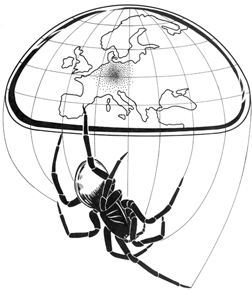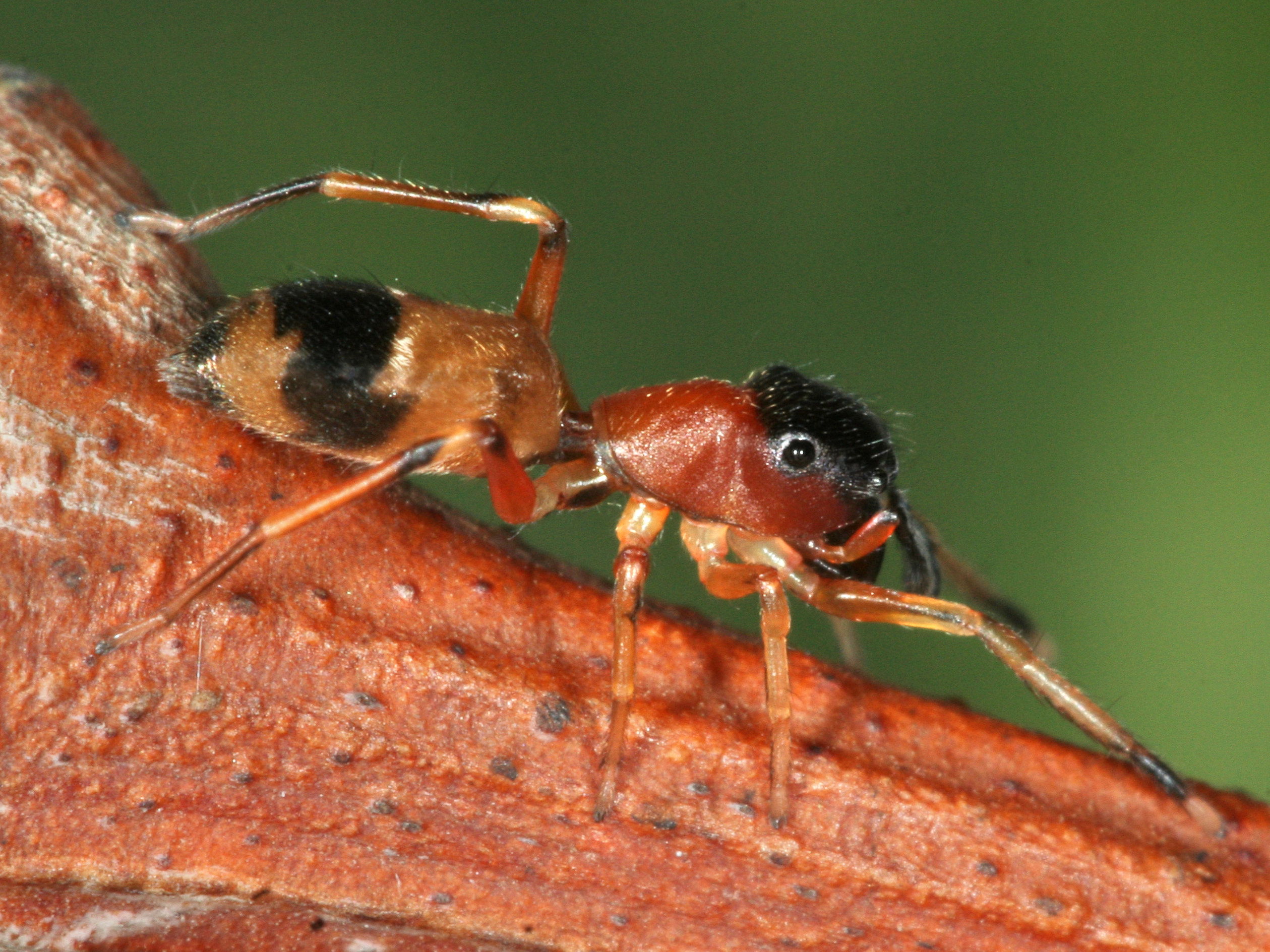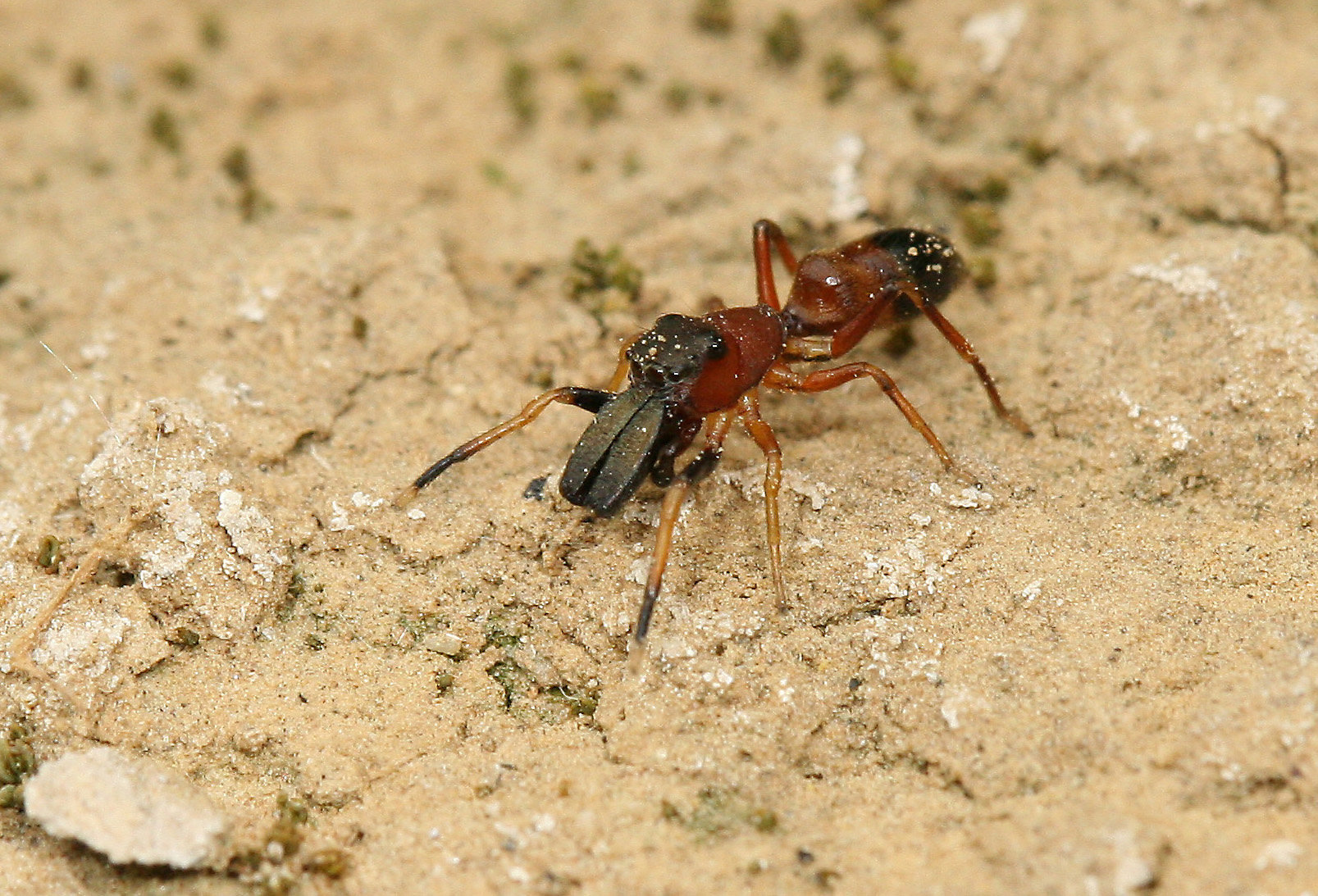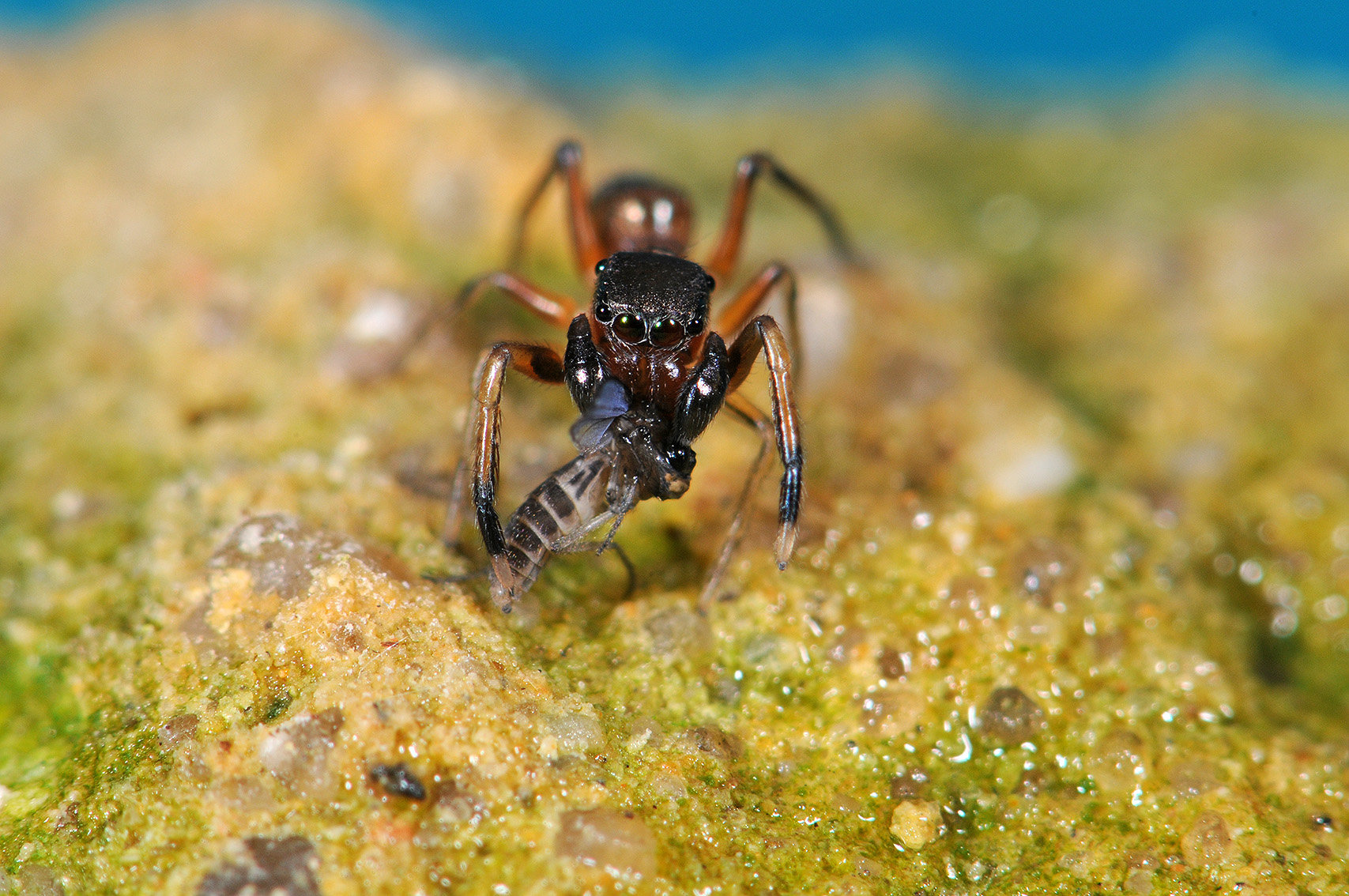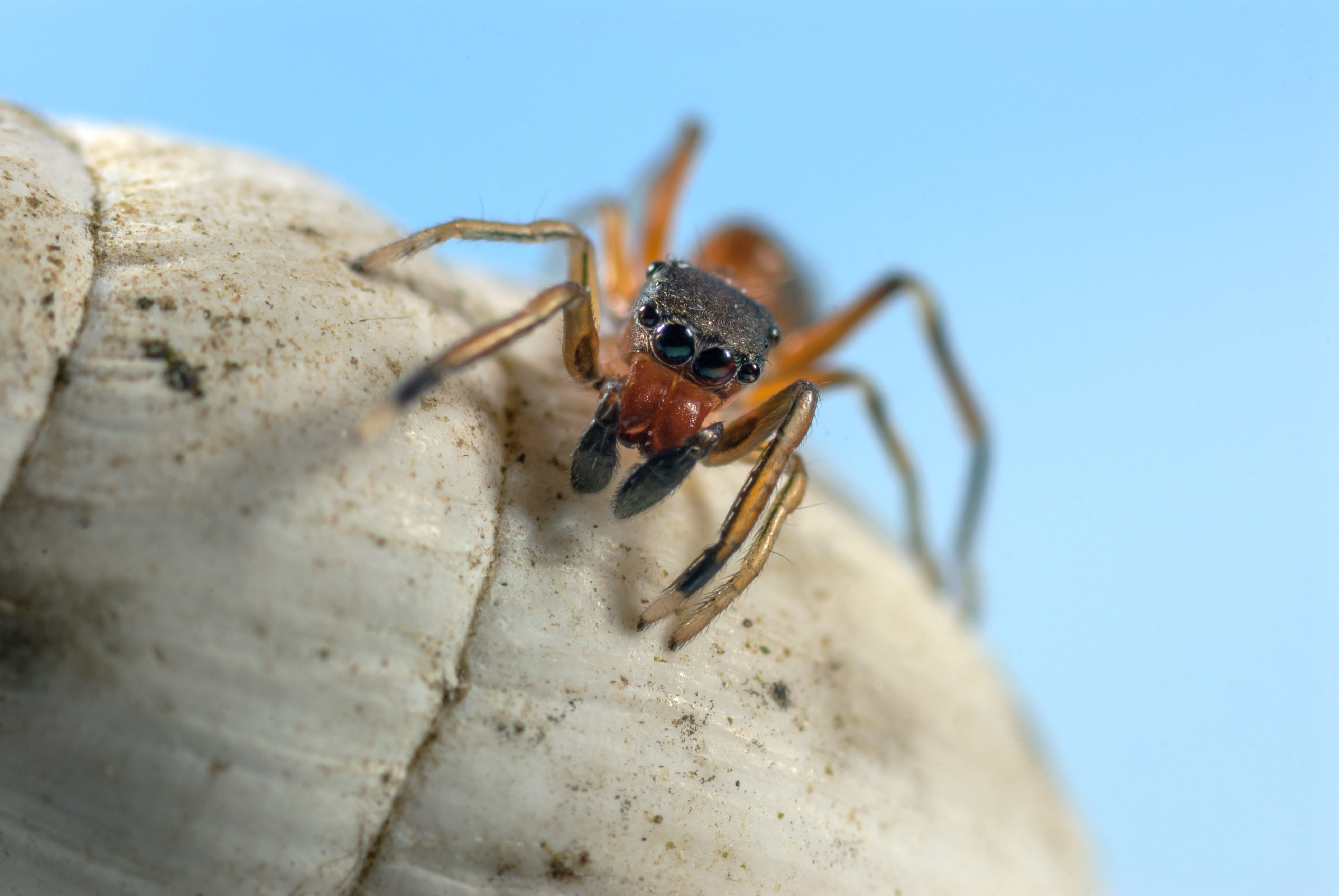Spider of the Year 2019
The ant mimic jumping spider Myrmarachne formicaria (De Geer, 1778)
Myrmarachne formicaria belongs to the jumping spider family (Salticidae). Worldwide, this family has 6,089 species, 345 of which are found in Europe. The genus Myrmarachne is represented by three species in Europe, whereby only this species is found in Central Europe.
Myrmarachne formicaria is distributed across the Palearctic, occurring naturally in Europe and introduced into the USA. In Austria and Germany, for example, it is found widely in flat to hilly areas up to 800 meters above sea level, where it particularly favours warmer areas. In places it can occur quite frequently and is not generally regarded as endangered.
Text: Christoph Hörweg & Jason Dunlop
Unlike many other jumping spiders which have compact bodies (e.g. the zebra jumping spider), Myrmarachne formicaria has an elongate and delicate body about 5 to 6.5 mm long which resembles that of an ant. The basic colouration of the cephalothorax is orange–brown with only the head area set off as darker. The elongate oval abdomen is yellow to orange–brown, with black colouration in the last third. The abdomen is connected to the cephalothorax by a narrow waist, similar to the petiolus of an ant. The legs are yellow to orange in colour with black marks and longitudinal stripes on the sides. The first pair of legs is banded and has very dark and slightly thickened metatarsi which resemble an ant’s antennae. Even the posterior eye pair is quite large, and in size and position similar to the eyes of an ant!
Females have normally developed mouthparts, but those of males extend more or less horizontally forwards and are both flattened and elongate. In this way the sexes can be easily told apart. During mating, males advertise themselves to females with their massive jaws. At the same time these mouthparts are also used in ritual battles in which two males stand opposed to each other and threaten their rival with their widely opened jaws.
Like all jumping spiders, the ant mimic jumping spider does not build a web for catching food, but waits for – or stalks – its prey. The spider lives primarily on the ground or in the leaf litter (i.e. an epigaen habitat) usually close the ants which they imitate such as Myrmica rubra or species of Formica. The spiders are found in various habitats, usually dry grassland or warm orchards, but can also be found in damp to wet localities such as moist meadows or reed banks.
Ant mimic jumping spiders can be found throughout the year with their main phase activity phase from April to August. It likes to overwinter in the empty shells of (terrestrial) snails.
The species imitates the appearance and movements of ants, but not in order to feed on them. The spider hunts small flies and midges, and also frequently plant pests such as aphids. The spiders profit more from the fact that ants, because of their aggressiveness, have relatively few enemies, thus the spiders are attacked less frequently by ichneumon or digger wasps, or birds. Ant mimicking jumping spiders are therefore a true example of protection mimicry.
Movements of the ants are also mimicked: in the first instance in how they walk. Instead of the more ‘typical’ abrupt jumping spider style, an ‘ant-like’ movement of short running phases and wave-like movements can be seen, as if they were an ant following a pheromone trail. Second, the spider generally uses only three of its four pairs of legs for walking, during which the first pair of legs is held up in the air, similar to the antennae of an ant. Thanks to specific movements of the legs the characteristic headlamp-shaped massive median eyes of the spider are cleverly concealed.
In Central Europe there are two other genera of jumping spiders resembling ants: Synageles und Leptorchestes. The ant spider Synageles venator is only 3 to 4 mm long, while Leptorchestes berolinensis is of similar size to the ant mimic jumping spider, but does not have the eye area raised in comparison to the rest of the cephalothorax.
Text: Christoph Hörweg & Jason Dunlop
The main reason is of course its ant mimicry, which not only concerns its body shape but also its copying of walking patterns and behaviour. It is a wonderful way for the jumping spider to avoid predation.
Through choosing the Spider of the Year we not only want to highlight a less popular group of animals, but also hope that scientists can contribute data about its current distribution. In this sense, enjoy the Spider of the Year and help us with your locality information or a photo to document this species.
The European Spider of the Year is chosen by 83 arachnologists from 26 European countries. Coordination of the vote is from the Natural History Museum of Vienna, together with the ‘Arachnologische Gesellschaft’ (AraGes) and the European Society of Arachnology.
Countries involved
Albania, Austria, Belgium, Bulgaria, Croatia, Czech Republic, Denmark, Finland, France, Germany, Great Britain, Hungary, Ireland, Italy, Liechtenstein, Macedonia, The Netherlands, Norway, Poland, Portugal, Serbia, Slovakia, Slovenia, Spain, Sweden, Switzerland.
Supporting societies
- ARABEL - Belgische Arachnologische Vereniging
- ARAGES - Arachnologische Gesellschaft
- BAS - The British Arachnological Society
- CAS - Česká arachnologická společnost
- ESA - European Society of Arachnology
- GIA - Grupo Ibérico de Aracnología
- NATURADATA - Biodiversidade online
- SPINED - European Invertebrate Survey-Nederland
Contact for Europe
Dr. Milan Řezáč
Biodiversity Lab, Crop Research Institute
Drnovská 507
161 06 Praha 6 – Ruzyně
Czech Republic
reza(a)cvurv.cz
- Arachnologische Geselschaft 2018 Atlas der Spinnentiere Europas (Arachnida: Araneae, Opiliones, Pseudoscorpiones, Amblypygi, Solifugae, Scorpiones, Schizomida) für Myrmarachne formicaria – (link) (10.12.2018)
- Bellmann H 2016 Der Kosmos Spinnenführer. Frackh-Kosmos Stuttgart. 429 pp.
- Blick T, Bosmans R, Buchar J, Gajdoš P, Hänggi A, Helsdingen P van, Růžička V, Staręga W & Thaler K 2004 Checkliste der Spinnen Mitteleuropas. Checklist of the spiders of Central Europe. (Arachnida: Araneae). Version 1. Dezember 2004
- Bradley RA, Cutler B & Hodge M 2006 The first records of Myrmarachne formicaria (Araneae, Salticidae) in the Americas. – The Journal of Arachnology 34: 483-484
- CSCF (Centre Suisse de Cartographie de la Faune) 2018 Fauna der Schweiz – Spinnentiere oder Arachniden (Skorpione, Pseudoskorpione, Spinnen, Weberknechte, Milben) – (link) bzw. Verbreitungskarte für Myrmarachne formicaria: (link) (10.12.2018)
- Cushing PE 1997 Myrmecomorphy and myrmecophily in spiders: a review. – Florida Entomologist 80: 165-193
- Foelix RF 2015 Biologie der Spinnen. Edition Chimaira, Frankfurt am Main. 430 pp.
- Hänggi A, Stöckli E & Nentwig W 1995 Lebensräume mitteleuropäischer Spinnen. Charakterisierung der Lebensräume der häufigsten Spinnenarten Mitteleuropas und der mit diesen vergesellschafteten Arten – Miscellanea Faunistica Helvetiae 4: 1-459
- Helsdingen PJ van 2016 Araneae. In: Fauna Europaea version 2017.06 – (link) (10.12.2018)
- Hula V, Niedobová J & Košulič O 2009 Overwintering of spiders in land-snail shells in South Moravia (Czech Republic). – Acta Musei Moraviae, Scientiae biologicae 94: 1-12
- Nentwig W & Heimer S 1984 Salticidae – Springende Spinnen: Vorstellung einer Spinnenfamilie. – Biologie in unserer Zeit 14(1): 1-5
- Nentwig W, Blick T, Gloor D, Hänggi A & Kropf C 2018 araneae – Spiders of Europe, version 12.2018 – (link) (10.12.2018)
- Reichholf JH & Steinbach G 1997 Die grosse Enzyklopädie der Insekten, Spinnenund Krebstiere, Band 1. Bertelsmann Lexikon Verlag Gütersloh. 360 pp.
- Steinberger K-H 2004 Zur Spinnenfauna der Parndorfer Platte, einer Trockenlandschaft im Osten Österreichs (Burgenland) (Arachnida: Araneae, Opiliones). – Denisia 12: 419-440
- Szinetár C, Gál Z & Eichardt J 1998 Spiders in snail shells in different Hungarian habitats. – Miscellanea Zoologica Hungarica 12: 67-75
- Wiki AraGes 2018 Wiki der Arachnologischen Gesellschaft e.V. – (link) (10.12.2018)
- World Spider Catalog 2018 World Spider Catalog, version 19.5. Natural History Museum Bern – (link) (10.12.2018)
